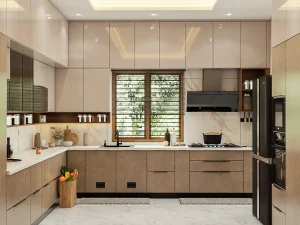
Kitchens are no longer mere workstations, but the heart of every home; the very place where living and design come together.
When you walk into your living space, evaluate how much space you have. An overly small kitchen could feel claustrophobic, and an overly large one could feel daunting or unnecessary.
Size
Some say that the bigger the kitchen the better, others say it depends on factors such as your lifestyle and the size of your home.Some people think that the bigger the kitchen the better. For instance, there are some large families that have a large amount of people living at home and in order to have enough space for every family member to fit comfortably and work simultaneously, the kitchen would need to be fairly large.Despite the above point, other people believe that the size of the kitchen depends on a number of factors including lifestyle and home size. For instance, there might be some individuals or couples who could be more comfortable with a smaller kitchen.For example, in my home, my dad has been planning on changing the kitchen in the house we live in recently.
Apart from the size, you also need to think about the layout and style of a kitchen plan. This needs to be struck at the right point between usefulness and prettiness, and have a look that appeals to you.
Make sure you select the best cabinet and counter heights for ergonomic use – for example, avoid having to reach up or bend down to access cabinets, which could put a strain on your back and neck – and make sure you have enough room for storage (have enough cabinets and pantry spaces installed to keep things uncluttered, or opt for an ‘open’ kitchen layout if you have the luxury of space so you don’t sacrifice your style or ability to prepare food efficiently).
Style
A choice of kitchen style will depend as much on personal aesthetics as it does on the architectural styles of your home: a super sleek modern kitchen can look out of place in an older Victorian-style home for instance.
Think about how you actually use your kitchen as you make decisions. For example, avid cooks might benefit from having the tools they use frequently right at hand or having their work triangle (sink, stove and fridge) laid out in a way that they can move efficiently through them. Keep things at hand that you use regularly – for example, have mugs stored near the coffee maker for easier mornings, or have plastic wrap handy for easy wrapping of stove top food.
If you do your homework and learn your footprint – that is, how much kitchen area you have and how you want to use it – you can devise zones for function and then propose a layout that supports those functions. Going this route will save money because it will let you select cabinetry and appliances that work best for the space, rather than having to modify your picks later.
Functionality
A functional kitchen is an important part of any household. Often, productivity and style seem at odds but, with a little expert advice, creating the kitchen of your dreams that also works for you is a doddle.
And as you decide how you want to arrange your kitchen, think about what kinds of tasks you do most frequently as you set it up. By placing items that you use all the time close together, you could save a considerable amount of waste. For example, when you want to make your morning coffee, it’s handy to have your coffee cup, coffee grounds and other items you need in the morning all close to your coffee machine to save you time. Or, perhaps plastic containers and wraps would come in handing while cooking and help you further cut down wasted food.
Be sure to follow the kitchen work triangle principle when you plan your layout as you need to be able to reach your cooking zone, your sink and your refrigerator when you actually need them. Keeping the flight paths of their three legs clear always help to move through the kitchen in a most unobtrusive way. When you visualise the kitchen layouts, you might get a sense of what would work best for you.
Budget
Not only does a good kitchen have to look the part – fine materials, appliances and accessories can ratchet up the price pretty quickly. Above all, though, make sure you know your budget and spend accordingly.
Assess Your Lifestyle
Consider how you and your family use the kitchen. If entertaining guests is part of your daily routine, it might be beneficial to have a more open design where you can talk while cooking or eating; but if you have young children, perhaps safety features and surfaces that are easy to clean might be vital.
The more you can appeal to as many people as possible with your design options, the higher you’ll be able to sell your home for when you’re done. You could go all out and create that walk-in wine cellar in your kitchen, which you’ll never regret. It’ll simply make it harder to sell your home to a buyer who doesn’t share your love for wine. Instead, you can get a more awesome kitchen with personal touches, while still dealing with professional kitchen design services to select the features that will have broad appeal. Again, this is all about using professional kitchen design services to identify an appropriate place on the classic versus modern kitchen style spectrum.






